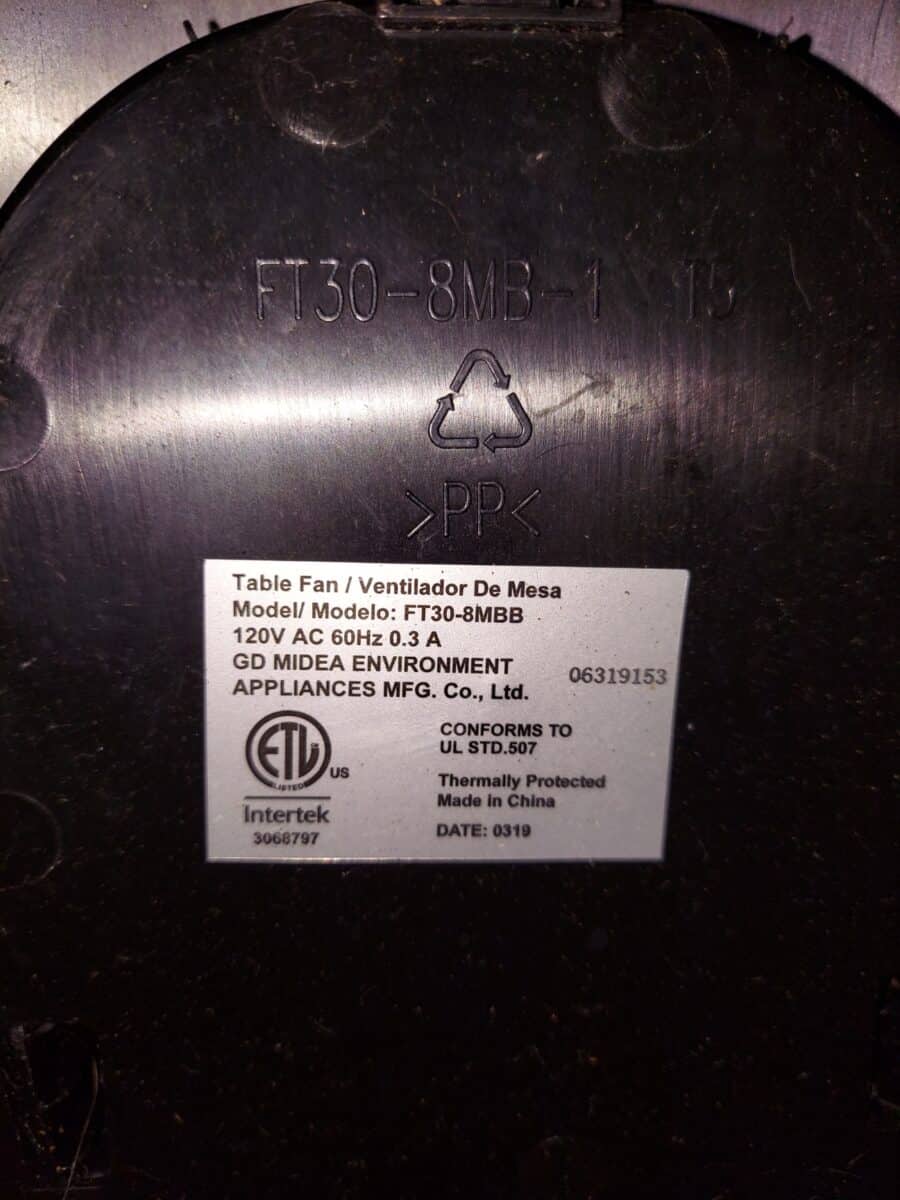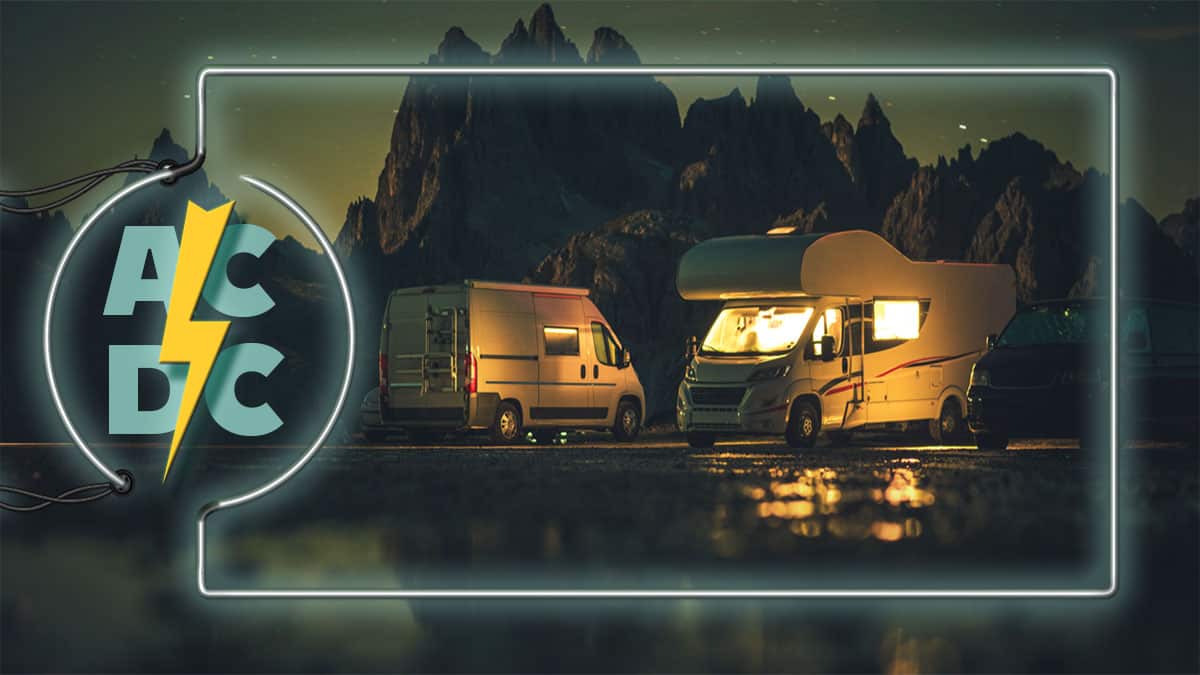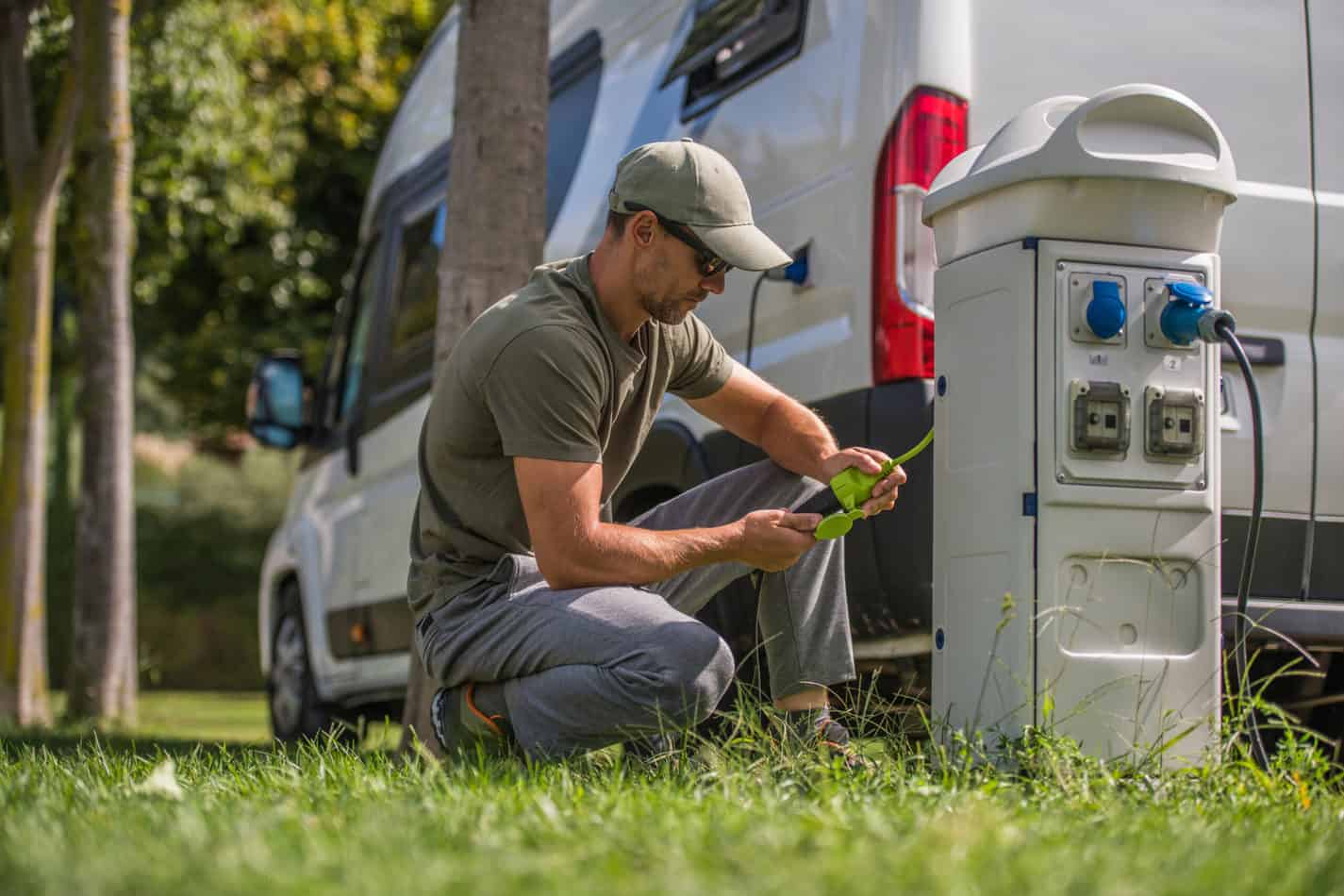Understanding RV Electricity Basics Can Keep You Safe
Throughout your life, you’ve heard the terms “amps,” “volts,” and “watts” concerning all things electrical. When you started RVing, the sales rep told you that your RV electrical system is a 30 or 50-amp. For most, all that means your RV electricity cord has three or four prongs.
Now that RV electric systems can go off-grid, RVers wanting to take advantage of this technology need to start paying attention to these RV electric terms and know how they apply to their coach.
In part 2 of our RV Electricity Series, we’ll discuss the three measurement terms of electricity and how they apply to RV electric systems. Now more than ever, these electric measurements are vital for off-grid RVers that use onboard electric generation devices for camping adventures. It can also come in handy for those with 30 amp RVs, limiting how many devices they can run simultaneously.
What We Know About AC/DC Power
In Part 1 of our RV Electricity Series, we discussed the difference between an RV’s Alternating Current (AC) and the Direct Current (DC) systems. For a quick refresher, your RV’s house batteries supply RV electricity to the DC power systems. The power you receive from the power box at the campground provides AC power.
RVs come with a converter (usually installed under or near the refrigerator) that changes the RV’s electricity from AC power to DC to charge your house batteries while you’re plugged in at the campground or elsewhere.
Today, many motorhomes and travel trailers come with an inverter that turns the DC battery power into AC electricity so you can watch TV, power kitchen appliances, and charge your laptop when your RV is not plugged into shore power.
The difference between AC and DC power is due to the flow of electrons. In DC power, electrons flow in only one direction between the positive and negative poles of the power source. With AC, electricity flows back and forth between positive and negative poles using magnets.
All batteries, including your tow vehicle, motorhome’s chassis, and RV house batteries, use DC power. The US electrical grid and your onboard generator supply AC power.
Defining The 3 Characteristics of Electricity
In the above video, the demonstration shows two bags filled with water. The demonstrator places barbell plates of different weights on each one. He then punctures each bag to show a stream of water that the weight’s pressure produces on the bag of water.
The result is that the heavier weight produces a longer stream of water than the smaller version. It’s a good analogy for how electricity works regarding volts, watts, and amps. Fortunately, the same measurements are used whether we are talking about AC or DC power.
1. Voltage (Volt or V)
Volts, or voltage, is the unit of measurement for electric potential difference, or electric pressure. It can also be thought of as the electrical force that pushes the electric charge through a wire. For example, in the demo video, the bigger weight represented a larger voltage because it put more pressure on the water bag.
So once the demonstrator punctured the bags, we saw a bigger water stream compared to the one with the smaller weight. Therefore, in electrical terms, the bigger water stream represented a higher voltage.
AC 120-volt is considered high or standard voltage. Your RV’s electric AC system runs your electrical outlets, RV air conditioners, and residential refrigerator. They need a high flow of energy. When you use an inverter, part of its job is to increase the voltage so these devices can operate correctly.
DC 12-volt systems like your ceiling lights, water pump, and coach heater operate at a lower voltage. When your RV is plugged into shore power, the converter is trickle charging the house batteries. So everything on the DC power grid receives power from the house batteries directly.
Please note that we’re keeping it simple, so we’re not factoring in a solar system or generator for this discussion. The following video has a more in-depth explanation of volts if you want to dive deeper into the subject.
2. Amperage (Amp or A)
Amps, or amperes, are the unit of measurement for electric current. Or, to put it another way, it’s the amount of electricity flowing past a particular point. Just like water flows through a pipe, electric charge flows through a wire. The rate at which the water flows is measured in gallons per minute, and the rate at which the electric charge flows is measured in amps. The more charge that flows through the wire in a given amount of time, the higher the current in amps.
Your RV’s electric system is rated at 30 or 50 amps. Unlike voltage which remains pretty constant at between 110-120V, when plugged into shore power, the amperage flowing through your RV electrical wires depends on how much power is being consumed by the various devices you are running. Anything that requires big motors or contains resistive elements intended to generate heat will require more power to run, therefore, will draw more amps.
Whether it’s the rooftop air conditioner, electric jack controller, or running your plugged-in Insta-Pot, the whole RV electric system needs the amp strength to keep the power hogs working efficiently while still having enough left over for the smaller electrical appliances and equipment.
To calculate amps, use the following formula:
Amp Draw (amps) = Power (watts) / Voltage (volts)
So to calculate the amp draw of a 1000W microwave, it would look like this:
1000W / 120VAC = 8.33A
So if you’re figuring out how many things you can run in your 30 amp RV, you can round the above number up to 9 and know that the combined amperage of other devices you can run along with the microwave can’t exceed 21 amps. Using this formula, it’s pretty easy to determine why a 30 amp rig might be able to run a 1000W microwave and a 2000W air conditioner for a short time which will pull about 26-ish amps, but if you turn on a 1200W coffee pot at the same time, you’ll trip breakers.
Electrical Safety: Amps + Volts Can Kill
Many people have heard that the amps can kill you in electricity, not the voltage. While this is true to some extent, it isn’t the whole picture. 12V batteries found in cars and RVs can deliver more than enough amps to kill a human (just 1 one amp can do it), but we don’t hear about car batteries zapping unsuspecting weekend mechanics into oblivion. The reason is the low voltage. Twelve volts just isn’t enough electrical pressure to send the electricity throughout your body. But remember, it is enough to be painful and cause burns under the right circumstances.
On the other hand, the electrical power coming from a 120V source is way more than enough to send that current into your body, and anything over 0.15 amps (150 milliamps) can cause severe injury or death. Keep in mind that just because an electrical circuit can put out 30 or 50 amps, that doesn’t mean it will have that many amps flowing through it all the time. Everything from the dryness of the person’s skin, what part of the body touches the electrical connection, and the path it travels through the body will determine a fatal shock from an uncomfortable one.
Can Voltage Throw You Across A Room?
We’ve all seen the TV trope of high-voltage sources throwing people backward. However, this is not entirely accurate; the power doesn’t launch people through the air. Electrical current above 6 to 30 milliamps (that’s thousandths of an amp) can cause the body’s muscles to contract involuntarily. Sometimes, that may cause a person’s hand to clamp onto an electrical source and be unable to let go. In other cases, the leg muscles are activated, which can cause a person’s body to throw itself. Regardless of the mechanism that causes them to be thrown, the end result is a possible blunt-force injury.
To better explain this, I have a friend who worked as a junior manager on a construction project. His boss asked him to look, not touch, the electrical connection on the top of a structure the company was building to verify everything was adequately secured.
Well, like a 5-year-old, he touched it, and it threw him 8 feet from the connection. Luckily he was okay and didn’t fall off the roof. Did I mention he was college educated with an engineering degree?
Had he been crouched or had different muscles been activated when he touched it, it may have been enough to send him off the roof, even if he didn’t receive a fatal shock. By the way, I did make sure to remind him how that college education was money “well spent” in a way only best friends talk to each other.
Motorhomes and travel trailers don’t have 440 amps flowing through them, but you can still injure yourself when working on the RV electric system. Ensure you disconnect the chassis and house batteries, and unplug from shore power whenever you work on your RV’s AC or DC system.
3. Wattage (Watts)
A volt measures “electrical pressure.” Amps measure how much electricity is coming out. Wattage measures the power. It answers the question, “how much overall energy is needed to operate the RV electrical device in question.” To answer that, it’s expressed in a simple equation:
voltage x amperage = wattage

For example, the Duxtop Induction Cooktop needs 120 volts and 15 amps to work correctly. When you multiply both of those numbers, it equates to 1,800 watts.
4. Watt-Hours (Wh)
1000 watts is referred to as a kilowatt. RVers who stay at long-term parks or monthly can be billed for their electrical usage in kilowatt-hours. Watts are often confused with watt-hours (Wh). Think of it like the speedometer vs. the odometer of a car.
Watts are like speed. You can travel at 25mph or 100mph, and the odometer doesn’t really care. It just logs how many miles total you have driven. If you drive 25mph for four hours or 100mph for one hour, your odometer will read 100 miles either way. It’s the same relationship between watts and watt-hours.
You can calculate the kWh usage of an appliance with the following formula:
Appliance Wattage (W) x Running Time = Power Consumed (Wh or kWh)
So a 2000-watt (2kW) air conditioner running for 5 hours a day would consume 10kWh of power per day.
2kW x 5 hours = 10kWh
Why Do RVers Need To Know About Amps, Volts, And Watts?
It’s very common for RV owners to show up to a campground, plug their rig into the socket that fits, and run appliances like they’re in a residential home. Those same RVers may wonder why their breakers are always tripping when they try to cook breakfast too.
When it comes to RV electricity, whether it’s figuring out your off-grid solar needs, daily electrical consumption needs, or any RV electricity issue, it’s important to know how electricity works. This knowledge can help you determine how many and what appliances you can run at once safely, especially if you have a smaller 30-amp rig. With the equations above, you can look at the sticker or stamp on any appliance you own and determine the device’s wattage and amperage.
If you’re heading out on a boondocking adventure, lot-docking on your way to your destination, or bouncing from one Harvest Hosts location to another, you need to know how to read and understand your RV’s electrical vital stats to keep the power going.
In a “better case” scenario, running out of RV electric power could mean no more TV, you can’t charge your mobile devices, and your RV refrigerator won’t keep your food cold anymore.
The “worst-case” scenario is that you lose medication that needs to stay cold, you can’t sleep in the 105°F temperature because the air conditioner won’t work, and the water pump stops drawing water in the bathroom (don’t ask, I don’t want to talk about it).
Knowledge is (Electric) Power
If you need help finding the amps, volts, and watts of a specific device, there should be a label on it that lists the measurements. For example, per the photo below, the oscillating fan we’ve used for years in our motorhome uses 120 volts. It has two- prongs and plugs into the 120-volt AC ports. On hot summer days here in Florida, it has helped move the cool air conditioning around our coach space wonderfully.

The amperage and watts are very low, so when we’ve been on the road, existing on battery or generator power, the fan has been a lifesaver.
For those looking to add a solar panel and bigger batteries to their RV electricity systems, you’ll need to know the amp, volt, and watt specs of everything. Solar panels are the slowest electric-generating devices, and their reality differs from their reputation. To learn more about RV solar systems, check out our discussions:
- How Much Solar Power Do I Need For My RV
- RV Solar Power For Air Conditioners
- Save Money This Winter With a DIY Solar Air Heater
Maintaining your electrical system Is Important
RV LIFE Maintenance is a cloud-based service that is part of the RV LIFE Pro subscription. It works on your tablet, computer, and smartphone. Use it to track upcoming maintenance dates and get detailed reminder emails showing what needs your attention and also the last time you performed that task, its costs, and related documentation. It also turns data into reports that let you access documents and see key dates instantly. Learn more!




